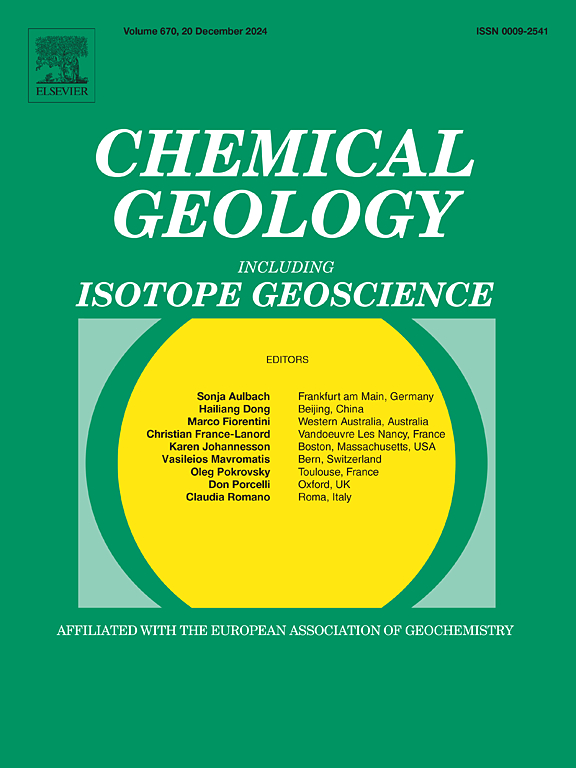寒武纪大爆发期间氧合增加:来自全球碳同位素记录的证据
IF 3.6
2区 地球科学
Q1 GEOCHEMISTRY & GEOPHYSICS
引用次数: 0
摘要
寒武纪早期的特点是在相对较短的时间间隔内迅速出现多种动物谱系,被称为“寒武纪大爆发”。这一时期,以后生动物为主的生态系统逐渐建立,后生动物的形态和生态复杂性不断提高。虽然地下环境的氧合增强通常被认为是这一前所未有的进化事件的主要驱动因素,但氧水平变化的相对幅度和潜在机制仍然难以捉摸。本文综合了全球分布的17个序列的高分辨率碳酸盐和有机碳同位素(δ13Ccarb和δ13Corg)记录,阐明了寒武纪第二晚期至第三阶段的碳氧循环动态,对应于寒武纪大爆发的顶点。我们的数据显示了与CARE(历史上称为寒武纪节肢动物辐射同位素偏移)同步的正Δ13C (δ13Ccarb -δ13Corg)偏移,这在δ13Ccarb和δ13Corg记录中都有显著的偏移,这表明海洋沉积物中有机碳埋藏增加。在含氧光合作用过程中,基于c同位素的O2依赖分值的数值模拟表明,这种碳同位素的转移对应于大气中O2水平的大幅增加。根据传统的c同位素质量平衡模型和各种沉积相的总有机碳(TOC)含量得出的独立O2估计进一步证实了有机质埋藏增强引起的大气O2增加。我们的研究结果揭示了推断的氧气水平上升与寒武纪大爆发之间的广泛时间对应关系,表明氧气供应的增加可能为寒武纪早期海洋后生动物的多样化和现代海洋生态系统的建立提供了有利的环境背景。本文章由计算机程序翻译,如有差异,请以英文原文为准。
Increased oxygenation during the peak Cambrian Explosion: Evidence from global carbon isotope records
The early Cambrian is characterized by the rapid emergence of diverse animal lineages within a relatively short time interval, known as the “Cambrian Explosion”. During this period, ecosystems dominated by metazoans were established, with an increase in morphological and ecological complexity of metazoan phyla. While enhanced oxygenation of subsurface environments has often been suggested as a primary driver of this unprecedented evolutionary event, the relative magnitude and underlying mechanisms of changes in O2 levels remain elusive. Here, we integrate high-resolution carbonate and organic carbon isotope records (δ13Ccarb and δ13Corg) compiled from 17 globally distributed successions to elucidate carbon‑oxygen cycle dynamics during the Cambrian late Stage 2 to Stage 3, corresponding with the apex of Cambrian Explosion. Our dataset reveals a synchronous positive Δ13C (δ13Ccarb–δ13Corg) excursion in phase with the CARE (historically termed as the Cambrian Arthropod Radiation Isotope Excursion), a significant excursion in both δ13Ccarb and δ13Corg records, which is interpreted as indicative of increased organic carbon burial in marine sediments. Numerical modelling based on the O2-dependent fractionation of C-isotopes during oxygenic photosynthesis suggests that this carbon isotope shift corresponds to a substantial increase in atmospheric O2 levels. Independent O2 estimates derived from traditional C-isotope mass balance models and the total organic carbon (TOC) contents of various sedimentary facies further corroborate a rise in atmospheric O2 caused by enhanced organic matter burial. Our findings reveal a broad temporal correspondence between inferred rising O2 levels and the acme of Cambrian Explosion, suggesting that increased oxygen availability may have provided a permissive environmental backdrop for the diversification of marine metazoans and the establishment of modern-like marine ecosystems during the early Cambrian.
求助全文
通过发布文献求助,成功后即可免费获取论文全文。
去求助
来源期刊

Chemical Geology
地学-地球化学与地球物理
CiteScore
7.20
自引率
10.30%
发文量
374
审稿时长
3.6 months
期刊介绍:
Chemical Geology is an international journal that publishes original research papers on isotopic and elemental geochemistry, geochronology and cosmochemistry.
The Journal focuses on chemical processes in igneous, metamorphic, and sedimentary petrology, low- and high-temperature aqueous solutions, biogeochemistry, the environment and cosmochemistry.
Papers that are field, experimentally, or computationally based are appropriate if they are of broad international interest. The Journal generally does not publish papers that are primarily of regional or local interest, or which are primarily focused on remediation and applied geochemistry.
The Journal also welcomes innovative papers dealing with significant analytical advances that are of wide interest in the community and extend significantly beyond the scope of what would be included in the methods section of a standard research paper.
 求助内容:
求助内容: 应助结果提醒方式:
应助结果提醒方式:


